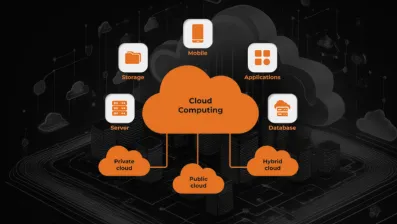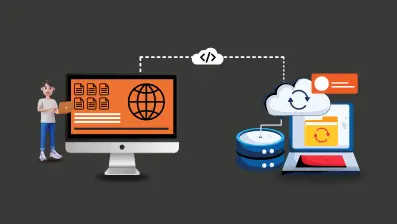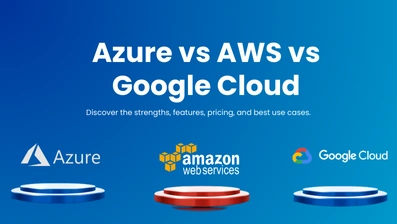So, you’ve got a brilliant app idea, and you’re thinking of taking it to the cloud. Smart move.
But let’s be real, before diving into the build, there’s one big question that’s probably on your mind: What’s the cost of cloud application development?
The cloud application development cost can go from $40,000 to $200,000+.
Whether you’re a startup planning your MVP or an enterprise looking to scale, understanding the budget you’ll need is crucial.
Cloud apps come with game-changing benefits – flexibility, remote accessibility, and easy scaling – but those perks come with a price tag that can vary widely.
This guide breaks it all down for you – no fluff, no guesswork.
You’ll learn what goes into building a cloud application, how the pricing works, and what you can expect based on your project needs.
Let’s start with the basics before we dive into numbers.
Overview of Cloud Application Development
Thinking about taking your app idea to the cloud? Great choice.
Cloud applications are becoming the go-to solution for businesses that want to scale fast, reduce infrastructure costs, and stay accessible from anywhere.
In simple terms, a cloud application is a software app that runs on cloud servers rather than on local machines. This means your users can access it anytime, on any device, as long as they have an internet connection.
Whether it’s a CRM platform, an eCommerce app, or a custom business tool-- cloud apps offer flexibility, improved performance, and easy updates.
Many businesses even pursue on-premises to cloud migration to modernize legacy systems, reduce IT overhead, and take advantage of cloud-native scalability.
With Cloud, you don't need to worry about local storage limits, maintenance, or downtime.
Plus, integrating features like real-time data sync, third-party APIs, and cloud databases becomes a whole lot smoother.
Now let’s talk money, because that’s usually the next big question.
How Much Does it Cost to Develop a Cloud Application?
This is the question every business owner asks: How much does it cost to develop a cloud application?
Well, the answer isn’t one-size-fits-all. The cost of cloud app development depends on a bunch of factors, including your app’s complexity, required features, tech stack, timeline, and whether you're hiring a development team or going solo with freelancers.
For example, a simple cloud-based task management app might cost you far less than a complex AI-driven enterprise platform.
Also, your costs will change depending on the cloud provider you choose — AWS, Google Cloud, Azure, etc.-- and the resources your app consumes over time.
But here’s the good news: cloud app development usually comes with lower infrastructure and maintenance costs in the long run.
You only pay for what you use, which is great for startups and businesses that want to stay lean.
Let’s break it down with a quick cost overview:
App Type | Estimated Cost Range | Development Time |
Simple Cloud App | $10,000 – $25,000 | 1 – 2 months |
Medium Complexity App | $25,000 – $50,000 | 2 – 4 months |
High Complexity App | $50,000 – $100,000+ | 4 – 6+ months |
Enterprise Cloud Solutions | $100,000 – $250,000+ | 6+ months |
MVP (Minimum Viable Product) | $8,000 – $20,000 | 1 – 2 months |
Factors Affecting the Cost to Develop a Cloud Application
When it comes to estimating the cost of cloud application development, there’s no single answer-- it’s like asking, “How much does a vacation cost?” Well… it depends. The same goes for cloud apps.
Here’s a deep dive into the major factors that influence your development costs-- explained with real-world context and supported by quick-reference tables.
1. App Complexity – More Brains = More Bucks
Not all cloud apps are created equal.
A simple to-do list app is worlds apart from an AI-powered analytics dashboard. The more logic, user flows, integrations, and customization your app requires, the more time and expertise it demands, and that drives up the cost of cloud app development.
Think of it like building a house. A single-room studio? Cheaper. A 5-bedroom smart home with voice-controlled lighting and a robot butler? That’s going to cost more.
Complexity Level | Features Included | Estimated Cost |
Basic | Login, dashboard, CRUD operations | $10,000 – $25,000 |
Moderate | User roles, real-time sync, integrations | $25,000 – $60,000 |
High | AI/ML, complex workflows, multi-tenant architecture | $60,000 – $150,000+ |
2. Cloud Infrastructure Provider – Choose Your Cloud Wisely
AWS, Google Cloud, and Azure might seem similar on the surface, but their pricing models can be very different. Each has its own way of charging for compute, storage, bandwidth, and even idle time.
That’s why it’s essential to compare Azure vs AWS vs Google Cloud when choosing a provider, not just based on cost, but on the services, tools, and ecosystem that best align with your application goal.
Beyond cost, some platforms offer better support, while others are stronger in AI tools or hybrid deployment.
You’re not just picking a server-- you're picking an ecosystem.
Provider | Compute Cost (t3.medium, 100 hrs) | Storage (100 GB SSD) | Support Plan (Basic) |
AWS | $18 | $10 | Free |
Google Cloud | $16 | $9 | Free |
Microsoft Azure | $20 | $11 | Free |
3. Third-Party Integrations – More Tools, More Time
If your app needs to integrate with third-party tools like Stripe for payments, Firebase for real-time sync, or Twilio for SMS, each of these adds development time and licensing costs.
More integrations = more moving parts = more testing = more budget.
But the tradeoff? Better user experience and feature richness.
Integration | Estimated Dev Time | API Fees (Monthly) |
Stripe Payments | 10–20 hrs | 2.9% + 30¢ per transaction |
Twilio SMS | 15–30 hrs | ~$0.0075 per SMS |
Firebase Realtime DB | 10–15 hrs | Free up to 1GB, then billed |
4. Team Location & Skill Level – Who’s Building It?
Hiring a mobile app development company from San Francisco is going to cost you a lot more than hiring from Eastern Europe or India. But beyond location, experience matters too.
A senior developer might charge more per hour but get the job done faster and with fewer bugs than a junior one.
Sometimes, cheaper isn’t really cheaper.
Region | Hourly Rate (Average) | Quality Level |
USA/Canada | $100 – $200/hr | High |
Western Europe | $60 – $120/hr | High |
Eastern Europe | $30 – $70/hr | Medium-High |
India/Philippines | $20 – $50/hr | Medium |
5. UI/UX Design – Good Looks Cost Money
A cloud app that looks outdated or clunky won’t win users. Investing in clean UI/UX design helps reduce friction, improve engagement, and even cut support costs.
Whether you’re going for minimalist dashboards or rich, animated experiences, great design takes time and thought.
Design is not decoration; it’s a core function.
Design Type | What’s Included | Estimated Cost |
Basic UI Kit | Colors, fonts, reusable components | $1,500 – $3,000 |
Custom UI + UX Flows | Wireframes, prototypes, personas | $4,000 – $8,000 |
Advanced Interactive UI | Animations, micro-interactions | $8,000 – $15,000+ |
6. Security & Compliance – Safety Isn’t Optional
If your cloud app handles sensitive data – like user credentials, payments, or healthcare info – you’ll need to meet certain standards (GDPR, HIPAA, etc.).
Cloud security should be a core part of your architecture, including encryption, two-factor authentication, and secure data handling. Skimping here can cost you way more later.
Skimping here can cost you way more later.
Security Feature | Development Time | Added Cost Estimate |
SSL Encryption | 5–10 hrs | ~$100/year (certs) |
2FA (Two-Factor Auth) | 15–20 hrs | ~$0.05 per login (SMS) |
GDPR Compliance Setup | 25–40 hrs | $2,000 – $5,000 |
7. Maintenance & Post-Launch Support – Don’t Forget the Afterwork
Your cloud app isn’t “done” at launch. You’ll need to keep it updated, monitor server health, fix bugs, and roll out new features.
Maintenance is often 15–20% of your initial cloud application development cost annually.
Think of it like owning a car. You don’t stop paying once you’ve bought it—you maintain it.
Task | Monthly Hours Needed | Estimated Cost/Month |
Bug Fixes & Updates | 10–20 hrs | $1,000 – $3,000 |
Server Monitoring | 5–10 hrs | $500 – $1,500 |
Feature Enhancements | 10–30 hrs | $1,500 – $5,000+ |
8. Time to Market – The Faster You Want It, The More You’ll Pay
Need your cloud app delivered in 2 months instead of 4? That urgency often means hiring a larger team, working overtime, or cutting corners elsewhere.
Speed has a price, and it’s not always just money. Rushed projects can lead to bugs, missed opportunities, or future rework.
Be clear about your timeline, but don’t sacrifice quality for a few saved weeks.
Timeline | Team Size Needed | Expected Cost Increase |
6+ months | 2–3 devs | Baseline cost |
3–4 months | 4–6 devs | +20% |
1–2 months (rush) | 6–10 devs + overtime | +40% or more |
How to Optimize the Cost of Cloud Application Development?
By now, it’s clear that the cost to develop a cloud application can vary widely depending on features, team size, infrastructure, and more. But here's the good news-- you don't need to break the bank.
With smart decisions and strategic planning, you can bring down the cost to build a cloud application without sacrificing quality.
Let’s walk through six actionable ways to optimize your cloud application development cost and keep your project lean and efficient.
1] Start with a Clear MVP – Don’t Build a Mansion First
You might have a big vision-- and that’s great-- but don’t try to build the entire dream app from day one.
Start with a Minimum Viable Product (MVP) that solves your users’ core problem. Launch fast, gather feedback, and iterate.
This not only reduces the cost to make a cloud application, but also saves time and avoids features that no one ends up using.
Bonus tip: MVPs attract investors faster because they show real traction.
2] Use Pre-Built Cloud Services – Don’t Reinvent the Wheel
Why spend thousands building something that already exists?
Cloud platforms offer a ton of services like user authentication (Firebase Auth), payment gateways (Stripe), databases (MongoDB Atlas), and file storage (AWS S3).
Using these tools can seriously cut down your development time-- and your cost to create a cloud application.
Think of it like using LEGO blocks instead of carving each piece from wood.
3] Choose the Right Tech Stack – Simplicity Wins
A common mistake? Picking trendy tech that’s overkill for your needs.
Your tech stack should be easy to scale, easy to maintain, and well-supported. Sometimes, simpler tools get the job done better-- and for less.
Choosing wisely reduces bugs, speeds up development, and lowers the cloud application development cost over time.
Pro tip: Avoid rare frameworks unless you have in-house experts.
4] Go Cross-Platform Where Possible – Code Once, Deploy Twice
If your cloud app needs to run on web, iOS, and Android, consider cross-platform frameworks like Flutter or React Native.
This way, you build one codebase and deploy it across platforms-- saving development time and reducing the cost to build a cloud application by up to 40%.
It’s like buying one outfit that works for multiple occasions.
5] Hire a Skilled Offshore Team – Smart Budget Move
Want quality work without sky-high hourly rates?
Hiring an experienced offshore development team can reduce your cost of cloud application development while still delivering great results.
Just make sure they’re fluent in your preferred language, follow agile practices, and have experience in cloud-based solutions.
Avoid freelancers who juggle five projects at once. Reliability matters.
6] Monitor & Optimize Cloud Usage – Pay Only for What You Use
Once your app goes live, the cost to maintain and scale a cloud application can sneak up on you-- especially if your infrastructure isn’t optimized.
Set up automatic scaling, monitor server usage, and avoid overprovisioning resources. This helps control the ongoing cloud app development cost and prevents wasteful spending.
Most cloud platforms even offer budgeting tools-- use them!
Want a quick recap of optimization tips? Here’s a handy table:
7] Cost Optimization Strategies at a Glance
Strategy | How It Helps |
Build an MVP First | Reduces initial investment and speeds up the feedback cycle |
Use Pre-Built Cloud Services | Saves dev time and lowers custom build costs |
Pick a Practical Tech Stack | Avoids complex, expensive-to-maintain solutions |
Choose Cross-Platform Frameworks | Cuts development time for multi-device apps |
Offshore Development Team | Delivers high-quality work at lower hourly rates |
Monitor Cloud Resource Usage | Prevents billing surprises and keeps cloud costs under control |
Let’s Build Something Great With DotStark (Without the Price Shock)
At DotStark, the best cloud application development company, we specialize in helping businesses like yours create cloud applications that are built to scale and built to stay within budget.
We don’t just build and bill. We partner with you to design, develop, and deliver solutions that align with your goals and your resources.
Whether you’re just estimating the cost to create a cloud application or ready to dive into development, we’re here to help.
- Transparent pricing
- Scalable architecture
- Proven cloud expertise
- A team that’s genuinely fun to work with
Final Thoughts
By now, you’ve probably realized that there’s no single number that answers the question, What’s the cost of cloud application development?
It depends on what you’re building, who’s building it, and how wisely you make decisions along the way.
But here’s the good news: when you approach it strategically, with the right features, the right team, and the right tools, you can absolutely build a powerful, scalable app without burning through your budget.
Whether your goal is to keep the cost to develop a cloud application lean or to get the most value out of every dollar you spend, smart planning is your best friend.
Frequently Asked Questions
The cost to develop a cloud application can range anywhere from $40,000 to $200,000+, depending on its complexity, features, design, and infrastructure choices. A basic MVP might cost under $40,000, while a full-scale enterprise cloud solution could push well beyond six figures.
Key factors include app complexity, design requirements, the development team’s location and experience, cloud infrastructure fees, third-party integrations, and post-launch support. All of these directly influence the cloud application development cost.
Start with a clear MVP, use pre-built cloud services, choose an efficient tech stack, consider cross-platform development, and partner with a skilled offshore team. These steps can significantly reduce the cost to build a cloud application while maintaining performance and quality.
Yes. While traditional apps often require more upfront infrastructure investment, cloud apps usually offer pay-as-you-go pricing, easier scalability, and lower long-term maintenance costs. In most cases, the cost to create a cloud application is more predictable and manageable.
Maintenance usually costs 15–20% of the initial development budget annually. This includes updates, performance monitoring, server costs, and new features. Optimizing cloud resource usage is key to managing the cost of cloud application development post-launch.














 +91 9680599916
+91 9680599916
 vanshika@dotstark.com
vanshika@dotstark.com
